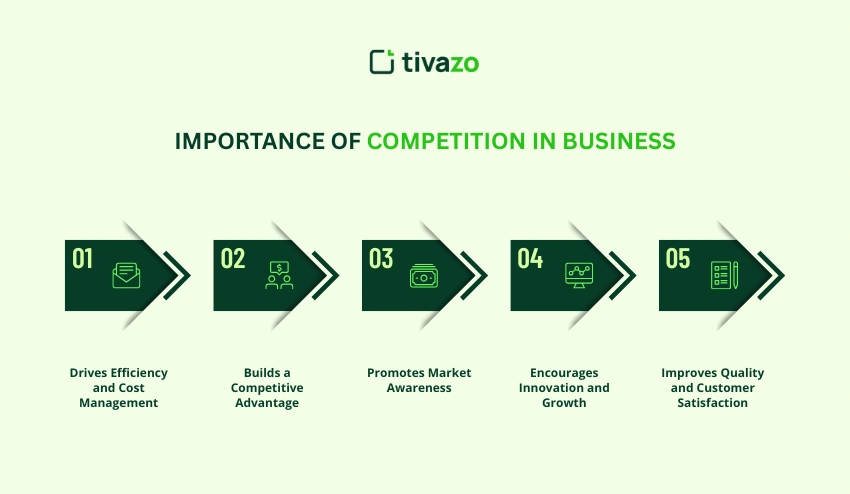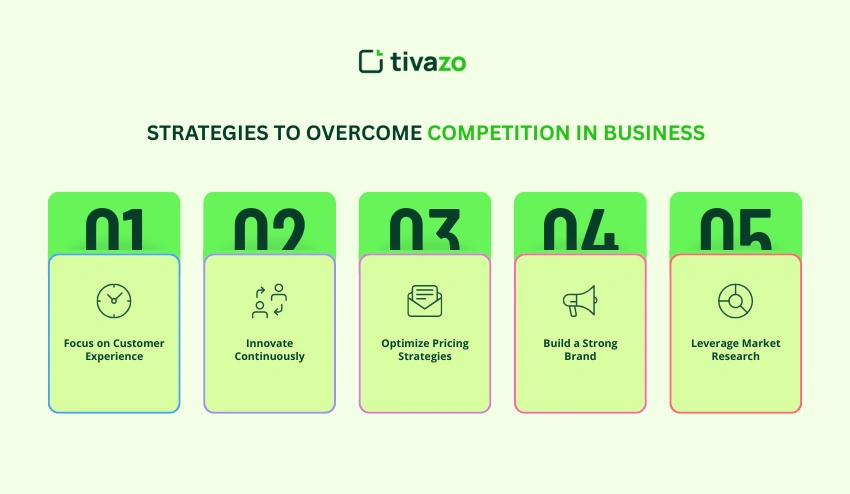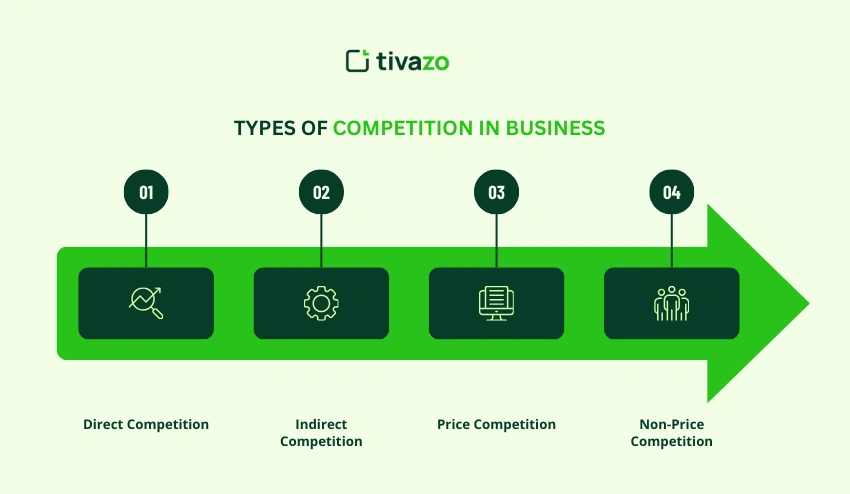In the current competitive world of business, there is no business that is independent. Each product, service, and idea is being confronted by some sort of business competition, and as such, every company is being forced to continuously be better.
So why is competition in business so important for growth? On the contrary, good business competition is healthy and is a source of innovation, better strategies, and makes customer satisfaction a key objective. The price competition, non-price competition, or market share, businesses that change fast usually come out stronger.
In business, competition is a challenge that is more than merely a challenge. Competition provides an opportunity for both small businesses and international enterprises by promoting creativity, efficiency, and flexibility. It makes companies relevant in evolving markets by supporting innovation, assisting brands to create a competitive edge, and so on. The ability to manage competition in the business is the most important in the long run success.
What is competition in business?
Competition in business is the rivalry between companies targeting the same customers with similar products or services. It can be price-based, where firms compete on cost, or non-price, focusing on quality, innovation, and customer satisfaction. Far from being negative, healthy competition fuels growth by driving innovation, improving efficiency, and giving consumers better choices. In simple terms, competition in business pushes companies to stay relevant and build a stronger market position.
Why is competition in business important?
Business competition is significant as it drives growth, inspires innovations, and ensures that customers get access to more quality products and services. Competitive market forces compel firms to enhance their efficiency levels, develop a competitive edge, and adjust to the evolving customer demands, and it is one of the major factors of success in the long term.

1. Drives Efficiency and Cost Management
Business competition urges firms to streamline business processes and cut costs that are irrelevant. The market trends, rivalry surveillance, and internal process enhancement allow businesses to operate with increased efficiency without sacrificing quality. This not only enhances profit margins but also makes products and services cheaper to the customers.
The effective competition in business also enables companies to adapt to market changes in a faster way. It may be the ability to modify pricing, reduce production, but the reason is that businesses that adopt competitive efficiency stand in a better position to survive and succeed within the ever-changing marketplace.
2. Builds a Competitive Advantage
Competition in businesses needs to be differentiated to be outstanding. Business competition will compel firms to find their unique selling points, enhance their brand, and generate a competitive advantage. Businesses can use innovation, customer experience, and strategic positioning as a competitive advantage over their competitors.
A competitive advantage also assists companies in gaining loyal customers and having a greater market share. Businesses can be kept relevant through training and planning, which will also lead to long-term success even when the industry is very competitive.
3. Promotes Market Awareness and Adaptability
Competition in business also enhances awareness of business trends, customer preferences, and new opportunities. Firms that keep an eye on their competitors and the market as a whole are able to project changes and respond swiftly, whether by introducing new products, revising services, or performing focused promotional efforts.
Flexibility within a competitive market guarantees that the business is flexible to market shocks. Through knowledge acquired during competition, businesses are able to develop strategies, enhance products, and remain superior so as to experience growth and remain competitive in the ever-evolving business environment, which is expected to be sustainable.
4. Encourages Innovation and Growth
The existence of healthy competition in business compels businesses to be creative and inventive. Competition in the business environment promotes advancement in technology, promotional policies, and consumer care, which helps companies to maintain a competitive edge over their competitors.
Such an innovation urge is not only an attraction to new customers but also a brand reputation. Organisations that welcome competition within business usually experience long-term growth and can have a leading role in the business industry.
5. Improves Quality and Customer Satisfaction
Competition in business encourages businesses to deliver value to their customers. Price competition makes the products affordable, whereas non-price competition focuses more on quality, features, and overall customer experience.
When businesses surpass the expectations of the customers, the result is a form of loyalty and market share. This quality and satisfaction in competitive markets have helped to keep companies relevant and successful.
How to start a competition in business?
Competition in business entails the establishment of a circumstance under which businesses or products can be compared, ranked, or rewarded on performance, innovation, or customer participation. To start with, the purpose of the competition, be it to increase brand awareness, become more innovative, attract customers, or reward the best players, must be identified.
Secondly, establish transparent rules, criteria, and measures that are fair. Market the competition using marketing channels and involve the participants. It doesn’t matter whether it is a sales competition, innovation competition, or customer loyalty competition; the idea is to promote growth, creativity, as well as healthy business competition. The right planning makes the competition inspiring, as well as establishing the presence of your brand and creating long-term relations with customers and partners.
How to overcome competition in business
The only way to surpass competition in business is by ensuring that a solid competitive advantage is developed by innovation, quality, and outstanding customer service. Research on your competitors, research on the market, and adjust your strategies. Providing differentiated value, combining efficiency and remaining flexible to customer demands, businesses would be able to survive even in the most competitive markets and ensure record growth.
Five strategies to overcome competition in business
The modern business world can be described as being very fast-paced, and competition in business is a must; no firm should be left behind. Effective strategies can be implemented to enable businesses to attract customers, better performance, and create a competitive advantage.

1. Focus on Customer Experience
Exceptional customer experience leaves a mark in a competitive market. Loyalty can be achieved and brand reputation built through meeting customer needs and surpassing expectations by the companies.
Customers will feel that they are important by investing in quality service, personalized interactions, and efficient support. Competition in business makes companies perfect these experiences, and thus it is a major point of difference.
It is a continuous process of enhancing the customer journey, which will increase customer attraction in addition to fostering repeat business. In a competitive market, customer satisfaction is an effective strategy that would generate a sustainable competitive edge.
2. Innovate Continuously
In order to succeed in business competition, continuous innovation is essential. The launch of new products, services, or processes enables firms to remain relevant and stand out from their competitors.
Positive competition in business makes companies seek an innovative way of solving problems and enhancing efficiency. Innovation can be used to grow and increase market presence, whether it is through technology, marketing, or service improvement.
With a culture of innovation, the businesses will be in a position to respond to the market changes at a faster rate and lead the pack. The ability to stay ahead of the competitors is the guarantee of success in the long run and flexibility.
3. Optimize Pricing Strategies
Proper pricing strategies would ensure that the businesses are kept competitive and still profitable. Price competition enables companies to gain access to cost-sensitive customers without losing value.
Knowledge of the market trends and pricing of the competitors will help businesses to be smart in pricing. Pricing strategies can be supplemented by non-price competition, like high quality or features, to create a better perception in the customer.
Pricing strategy balanced has the effect of increasing market share, enhancing satisfaction among customers, and consolidating the overall competitiveness. Pricing is one of the tools that can be used in business to be ahead of competitors and to maintain growth.
4. Build a Strong Brand
An excellent brand creates a distinction in your business and loyalty to your customers. Brand name, fame, and repetition of messages make a business visible in a saturated market.
Competition in business makes companies polish their branding, communicate their value, and build trust with clients. A high branding can also lead to a psychological advantage where the customers prefer what you are offering over theirs.
Branding activities are what will help the company remain recognizable and secure enough to stand the test of the market. A properly placed brand builds your competitive edge and provides long-term growth.
5. Leverage Market Research
The market research gives an insight into competitors, their likes, and the latest trends. Knowledge of the competition enables businesses to make decisions that are well informed and plan well.
Periodic studies point out areas of weakness and places to stand out. It also assists businesses in predicting the market changes, changing quickly, and remaining competitive in the competition.
Through the application of market research, the business would be able to perfect their approach, refine their offerings, and increase their competitiveness. Making evidence-based decisions is the necessary condition of overcoming competition in business and ensuring long-term success.
To overcome the competition in business, one has to adopt strategic planning, innovation, and customer focus. With these five strategies, companies will be able to increase their standing in the market, enhance customer loyalty, as well as attain sustainable growth.
Types of competition in business
There are various forms of competition in business, and each type of competition determines the way businesses run and compete in the market. Knowledge of such kinds helps companies come up with viable strategies to succeed.

1. Direct Competition
Direct competition is a competition between two or more businesses that produce the same or similar products or services, to the same target market. As an illustration, two brands of smartphones that are competing in the market share the customer base. Such competition makes firms be innovative, enhance quality, and be able to differentiate their products with a view to achieving market share.
2. Indirect Competition
The situation of indirect competition occurs when the businesses offer alternative products or services that meet the same customer need. As an example, a smoothie bar and a coffee shop can be competitors who do not compete in a direct way but present people with the opportunity to choose a suitable refreshment. The identification of indirect competitors will enable the firms to know the threats and how they can capitalize on the opportunities to capture customers in the same markets.
3. Price Competition
Price competition involves the ability to attract customers with reduced prices at a profitable level. In order to beat competitors, companies usually cut down on expenses, provide discounts, or come up with value packages. This kind of competition is prevalent in very saturated markets where consumers are very sensitive to pricing variations.
4. Non-Price Competition
Instead of focusing on price, non-price competition accents on quality, features, brand appeal, and customer experience. The various ways of differentiating businesses in the market are innovation, marketing, customer service, and product uniqueness. Such healthy competition in business will motivate companies to constantly become better and provide more value to customers.
5. Monopolistic Competition
In monopolistic competition, there are a lot of firms that produce similar but not the same commodities, and as such, each firm has a certain influence on the pricing. Some of the strategies in this kind of market include product differentiation, branding, and marketing. This model of competition in business enhances innovation and increases customer preferences, and also enables businesses to have some power in the market.
6. Oligopoly
Oligopoly is a situation in which the market is controlled by a small number of large businesses that shape the price and the market patterns. Companies should be keen on the moves of their competitors and plan on how to be competitive. In an oligopoly, competition in business tends to revolve around brand strength, customer loyalty, and innovation in order to differentiate.
Examples of Competition in Business
Business competition may be observed in business both at small local levels, as well as international companies. It can be observed with the examples in the real world in order to realize how competition creates strategies and leads to development.
1. Technology Industry
Smartphones, tablets, and wearables. Tech giants such as Apple and Samsung compete directly against each other. The resulting competition is direct, which has led to unrelenting innovation, improved customer experience, and innovativeness.
2. Retail Sector
The retailers, such as Walmart and Target, compete on prices through discounts, reward programs, and promotions. There is also the non-price competition, which they are based on store experience, product variety, and brand reputation.
3. Food & Beverage Industry
The competition among fast-food restaurants like McDonald’s and Burger King is based on price, variety of menu, and customer care. There is also indirect competition that involves cafes and casual restaurants, which compete with the restaurant in terms of consumers who want to have quick meals.
4. Automotive Industry
Firms such as Toyota and Ford are in competition for vehicle quality, prices, and features. The tools that become important in order to acquire a competitive advantage in this sector are innovation, marketing, and customer satisfaction.
5. E-commerce Platforms
Amazon and eBay are direct and indirect rivals that compete with similar products, speed, and favorable offers. The competition causes the platforms to be innovative when it comes to logistics, user experience, and customer service.
The given examples demonstrate that competition in business leads to innovation, to the improvement of quality, and to the creation of customer value. Organisations that learn and adjust to their competitive environment have better chances of attaining success in the long term.
Conclusion
Competition in business is not only an issue; it is a driver to development, innovation, and success in the long run. With the knowledge of the various forms of competition, the experience of real-life examples, and the application of the strategies of enhancing customer experience, perpetual innovation, effective pricing, good branding, and market research, firms can create a competitive advantage and succeed in any marketplace. The good, healthy competition in business leads to efficiency, creativity, and the provision of better products and services to customers, thus making a business remain relevant to the market, win market share, and sustain growth in the ever-changing business environment.




